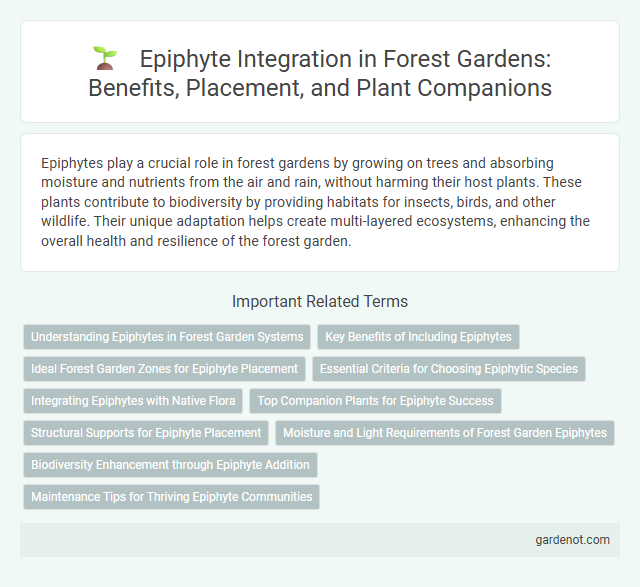Epiphytes play a crucial role in forest gardens by growing on trees and absorbing moisture and nutrients from the air and rain, without harming their host plants. These plants contribute to biodiversity by providing habitats for insects, birds, and other wildlife. Their unique adaptation helps create multi-layered ecosystems, enhancing the overall health and resilience of the forest garden.
Understanding Epiphytes in Forest Garden Systems
Epiphytes are vital components of forest garden systems, growing non-parasitically on trees and other plants while deriving moisture and nutrients from the air and rain. These plants contribute to biodiversity by providing habitat for insects and birds, stabilizing microclimates, and enhancing nutrient cycling within the ecosystem. Understanding epiphyte species diversity, water uptake mechanisms, and their symbiotic relationships is crucial for integrating them effectively in forest garden design and maintenance.
Key Benefits of Including Epiphytes
Epiphytes enhance forest garden biodiversity by providing habitat and microclimates for insects and birds without competing for soil nutrients. Their ability to absorb moisture and nutrients from the air helps regulate humidity and improve air quality within the garden ecosystem. Incorporating epiphytes supports natural pest control and promotes a resilient, self-sustaining environment.
Ideal Forest Garden Zones for Epiphyte Placement
Epiphytes thrive best in Forest Garden Zones 2 and 3, where partial shade and consistent humidity mimic their natural canopy habitat. These zones provide the dappled sunlight and sheltered microclimate essential for epiphytes like orchids, bromeliads, and ferns to absorb moisture and nutrients from the air. Strategic placement on tree branches and in protected nooks enhances air circulation and moisture retention, optimizing epiphyte growth and ecosystem integration.
Essential Criteria for Choosing Epiphytic Species
Selecting epiphytic species for a forest garden requires evaluating their adaptability to local climate, humidity levels, and light availability to ensure optimal growth and survival. Essential criteria include compatibility with host trees without causing harm, root structure suited for anchoring onto branches, and moisture retention capabilities to thrive in aerial environments. Prioritizing native or well-adapted epiphytes enhances biodiversity and contributes to the ecological balance within the forest garden ecosystem.
Integrating Epiphytes with Native Flora
Integrating epiphytes with native flora enhances biodiversity by creating layered habitats within forest gardens, promoting natural ecosystems and improving air quality. Selecting native epiphyte species that complement the local flora ensures ecological balance and supports pollinators and other wildlife. Effective placement on host trees maximizes sunlight exposure and moisture retention, fostering healthy growth and symbiotic relationships.
Top Companion Plants for Epiphyte Success
Top companion plants for epiphyte success include bromeliads, orchids, and ferns, which provide similar humidity and light conditions while enhancing biodiversity. Mosses and lichens also create supportive microhabitats that retain moisture and promote healthy root systems. Selecting host trees with rough bark and ample canopy cover further ensures optimal epiphyte attachment and growth in forest gardens.
Structural Supports for Epiphyte Placement
Epiphytes rely on structural supports such as tree branches, trunks, and man-made frameworks to anchor and thrive in forest gardens. These supports provide the necessary stability and access to sunlight without extracting nutrients from the host plant, promoting a symbiotic ecosystem. Selecting durable, moisture-retentive materials for artificial supports enhances epiphyte growth and mimics natural habitats effectively.
Moisture and Light Requirements of Forest Garden Epiphytes
Forest garden epiphytes thrive in environments with high humidity and indirect, filtered light, mimicking their natural tropical and subtropical habitats. These plants absorb moisture from the air and rain, requiring consistent atmospheric moisture levels above 60% to prevent dehydration. Shade-tolerant epiphytes prefer dappled sunlight beneath the forest canopy, avoiding direct midday sun to reduce leaf scorch and optimize photosynthesis.
Biodiversity Enhancement through Epiphyte Addition
Epiphytes significantly enhance biodiversity in forest gardens by providing critical habitats and microclimates for various insects, birds, and small mammals. Their unique ability to grow on host trees without harming them increases vertical complexity, promoting diverse ecological interactions and nutrient cycling. Adding epiphytes contributes to a richer, more resilient ecosystem by supporting species that rely on these specialized plants for food, shelter, and breeding grounds.
Maintenance Tips for Thriving Epiphyte Communities
Epiphytes thrive in environments with high humidity and indirect sunlight, requiring minimal soil but consistent moisture through regular misting or gentle watering. Maintaining good air circulation and ensuring attachment to stable, well-draining substrates like tree branches or specially designed mounts supports healthy growth and reduces disease risk. Periodic pruning and inspection for pests prevent overgrowth and promote vibrant, sustainable epiphyte communities within forest garden ecosystems.
Epiphyte Infographic

 gardenot.com
gardenot.com